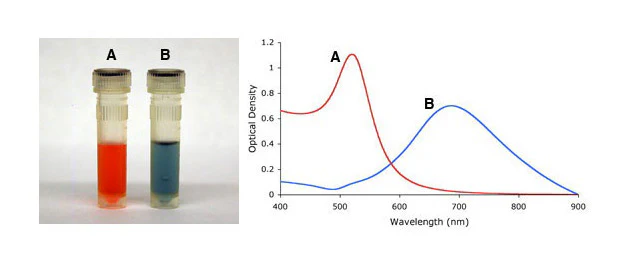UV-vis vs TEM for Nanoparticle Analysis
Nano particles in biotech
Gold nanoparticles are widely use in biomedical applications, and their optical properties are crucial for their functionality.
I did some work on nanoparticles before. For medical applications, the size and shape of the nanoparticles can affect their optical properties, which in turn can influence their interaction with biological systems. Companies struggle with the quality control, as nano particles cannot be inspected with optical microscopes.
The direct way of measuring the size of nanoparticles is to use electron microscopy (TEM), which is expensive and time consuming.
UV-Vis vs TEM
| Aspect | TEM | UV-Vis SPR |
|---|---|---|
| What it measures | Individual particle size/shape | Ensemble optical properties |
| Sample needed | ~1 drop, dried | ~1 mL in solution |
| Time | Hours (prep + imaging) | Minutes |
| Statistics | ~100-1000 particles | ~10¹² particles |
| Sample state | Dried on grid | In solution |
| Information | Actual size/shape | Optical properties |
| Initial investment | $500,000 - $2,000,000 | $20,000 - $80,000 |
| Cost per run | $100-$500 | $1-$10 |
| Operating costs | • ~$300/hour facility time • Expensive maintenance • Specialized technician • Vacuum pumps • Cooling systems |
• Minimal maintenance • Standard lab personnel • Lamp replacement (~$200/year) • Cuvettes (~$1-50 each) |
| Infrastructure needs | • Vibration-free room • Stable power supply • Temperature control • Often dedicated building |
• Standard lab bench • Regular power outlet |
TEM Costs:
- Initial: Basic TEM ~$500K, High-resolution ~$2M+
- Annual maintenance: $20,000-$50,000
- Consumables: Grids ~$5-10 each, stains, chemicals
- Personnel: Requires trained operator ($70K-$100K/year)
UV-Vis Costs:
- Initial: Basic ~$20K, Research-grade ~$80K
- Annual maintenance: $1,000-$3,000
- Consumables: Cuvettes (reusable), solvents
- Personnel: Any trained lab member can operate
This cost difference is a key motivation for the ML approach in this paper - getting TEM-like information from affordable UV-Vis measurements!
UV/Vis setup
For UV/Vis spectroscopy, cold particles are often in a colloidal suspension with 0.01 - 1 mg / mL.
Light Source → Sample in Cuvette → Detector
↓ ↑
(UV-Vis lamp) (Measures transmitted light)- Standard UV-Vis spectrophotometer
- Quartz or plastic cuvette (1 cm path length typical)
- Wavelength range: usually 300-1200 nm
- Reference: blank solvent in matching cuvette
Nano particles have a surface plasmon resonance (SPR) peak in the UV-Vis spectrum, which is sensitive to their size, shape, and environment. Read my notes here.
